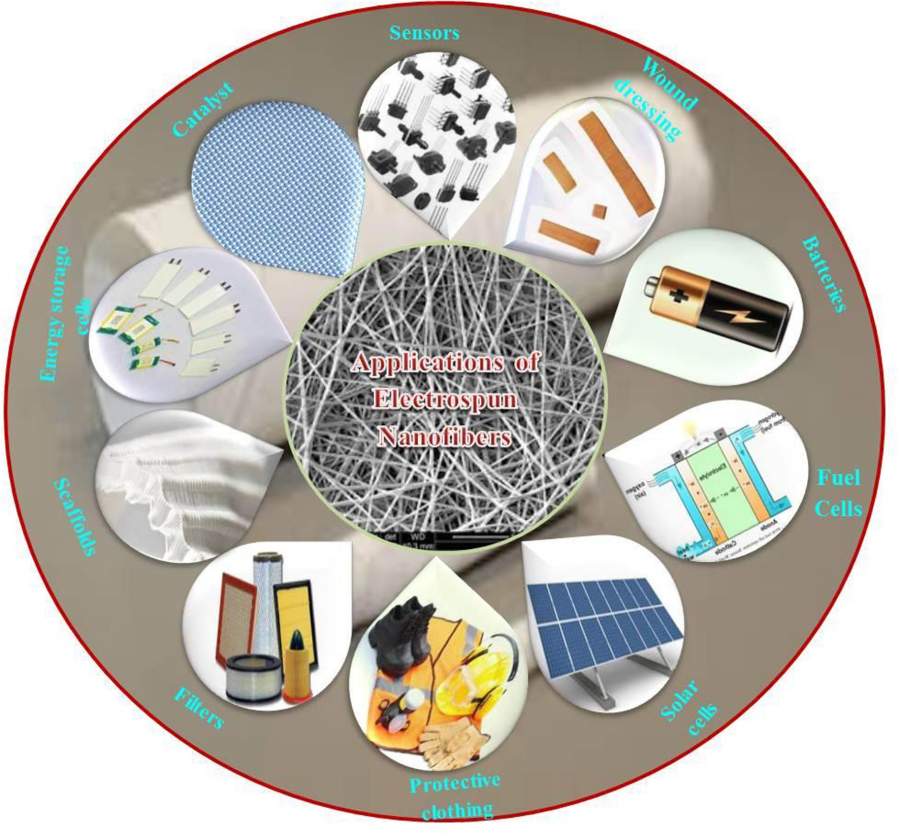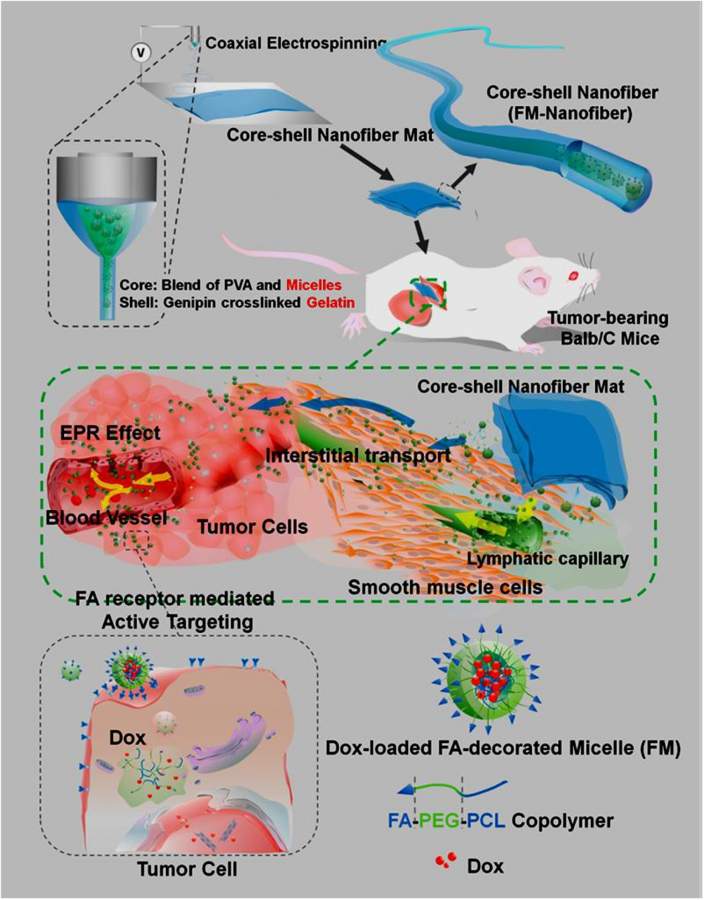静电纺丝综述:未来先进纤维材料应用
Electrospun nanofibers: New generation materials for advanced applications
abstract: Electrospinning (E-spin) is a unique technique to fabricate polymeric as well as metal oxide nanofibers. Research on electrospun nanofibers is a very active field in material science owing to their novel applications in diverse domains. The main focus of this review is to provide an insight into E-spin technique by understanding the working principle, influencing parameters and applications of nanofibers in different walks of life. Several hundreds of papers are published on the preparation, modification and applications of nanofibers produced by E-spin technique in the areas like sensor development, decontamination, energy storage, biomedical and catalysis etc. Details on the industrial scale development of E-spin technique, current scenario and future developments are also covered in this review.
Contents
1. Introduction . . . . . . . . . . . . . . . . . . . . . . . . . . . . . . . . . . . . . . . . . . . . . . . . . . . . . . . . . . . . . . . . . . . . . . . . . . . . . . . . . . . . . . . . . . . . . . . . . . . . . . . . . . 37
2. History and evolution of E-spun NFs research . . . . . . . . . . . . . . . . . . . . . . . . . . . . . . . . . . . . . . . . . . . . . . . . . . . . . . . . . . . . . . . . . . . . . . . . . . . . . . . 37
3. Working principle, instrumentation and operational parameters. . . . . . . . . . . . . . . . . . . . . . . . . . . . . . . . . . . . . . . . . . . . . . . . . . . . . . . . . . . . . . . . 37
3.1. Working principle . . . . . . . . . . . . . . . . . . . . . . . . . . . . . . . . . . . . . . . . . . . . . . . . . . . . . . . . . . . . . . . . . . . . . . . . . . . . . . . . . . . . . . . . . . . . . . . . 37
3.2. Instrumentation. . . . . . . . . . . . . . . . . . . . . . . . . . . . . . . . . . . . . . . . . . . . . . . . . . . . . . . . . . . . . . . . . . . . . . . . . . . . . . . . . . . . . . . . . . . . . . . . . . 37
3.3. Operational parameters . . . . . . . . . . . . . . . . . . . . . . . . . . . . . . . . . . . . . . . . . . . . . . . . . . . . . . . . . . . . . . . . . . . . . . . . . . . . . . . . . . . . . . . . . . . 39
3.3.1. Solution parameters . . . . . . . . . . . . . . . . . . . . . . . . . . . . . . . . . . . . . . . . . . . . . . . . . . . . . . . . . . . . . . . . . . . . . . . . . . . . . . . . . . . . . . . 39
3.3.2. Instrumental parameters . . . . . . . . . . . . . . . . . . . . . . . . . . . . . . . . . . . . . . . . . . . . . . . . . . . . . . . . . . . . . . . . . . . . . . . . . . . . . . . . . . . 39
3.3.3. Ambient parameters. . . . . . . . . . . . . . . . . . . . . . . . . . . . . . . . . . . . . . . . . . . . . . . . . . . . . . . . . . . . . . . . . . . . . . . . . . . . . . . . . . . . . . . 40
4. Applications of electrospun nanofibers. . . . . . . . . . . . . . . . . . . . . . . . . . . . . . . . . . . . . . . . . . . . . . . . . . . . . . . . . . . . . . . . . . . . . . . . . . . . . . . . . . . . . 41
4.1. Biomedical applications of E-spun nanofibers. . . . . . . . . . . . . . . . . . . . . . . . . . . . . . . . . . . . . . . . . . . . . . . . . . . . . . . . . . . . . . . . . . . . . . . . . . 41
4.1.1. Wound dressing material. . . . . . . . . . . . . . . . . . . . . . . . . . . . . . . . . . . . . . . . . . . . . . . . . . . . . . . . . . . . . . . . . . . . . . . . . . . . . . . . . . . 41
4.1.2. Scaffolds . . . . . . . . . . . . . . . . . . . . . . . . . . . . . . . . . . . . . . . . . . . . . . . . . . . . . . . . . . . . . . . . . . . . . . . . . . . . . . . . . . . . . . . . . . . . . . . . 43
4.1.3. Drug delivery . . . . . . . . . . . . . . . . . . . . . . . . . . . . . . . . . . . . . . . . . . . . . . . . . . . . . . . . . . . . . . . . . . . . . . . . . . . . . . . . . . . . . . . . . . . . 43
4.2. Applications of E-spun NFs in chemistry . . . . . . . . . . . . . . . . . . . . . . . . . . . . . . . . . . . . . . . . . . . . . . . . . . . . . . . . . . . . . . . . . . . . . . . . . . . . . . 43
4.2.1. Catalyst . . . . . . . . . . . . . . . . . . . . . . . . . . . . . . . . . . . . . . . . . . . . . . . . . . . . . . . . . . . . . . . . . . . . . . . . . . . . . . . . . . . . . . . . . . . . . . . . . 43
4.2.2. Cells and batteries . . . . . . . . . . . . . . . . . . . . . . . . . . . . . . . . . . . . . . . . . . . . . . . . . . . . . . . . . . . . . . . . . . . . . . . . . . . . . . . . . . . . . . . . 44
4.3. Applications of E-spun nanofibers in defence . . . . . . . . . . . . . . . . . . . . . . . . . . . . . . . . . . . . . . . . . . . . . . . . . . . . . . . . . . . . . . . . . . . . . . . . . . 45
4.3.1. Protective clothing and sensors . . . . . . . . . . . . . . . . . . . . . . . . . . . . . . . . . . . . . . . . . . . . . . . . . . . . . . . . . . . . . . . . . . . . . . . . . . . . . . 45
4.4. Applications of E-spun nanofibers in environmental protection . . . . . . . . . . . . . . . . . . . . . . . . . . . . . . . . . . . . . . . . . . . . . . . . . . . . . . . . . . . 45
4.4.1. Removal of toxic wastes by NFs . . . . . . . . . . . . . . . . . . . . . . . . . . . . . . . . . . . . . . . . . . . . . . . . . . . . . . . . . . . . . . . . . . . . . . . . . . . . . 45
Current scenario and future work
Electrospinning is a promising technology to produce submicron size fibers i.e., NFs from the laboratory level to industrial level. Several hundreds of papers reported the preparation, characterization and applications of NFs. Generally, nanomaterials possess large surface area, which is considered as an advantage for applications in many fields. Particularly, electrospun nanofibers received special attention in biomedical field due to their biocompatibility, adhesiveness and sterile nature. Applications are also extended to areas like, filters, protective clothing, membranes, sensors, energy storage devices and catalysis. Currently, NFs are considered as suitable candidates in wound dressing materials, scaffold materials, drug delivery systems, filtration membranes, catalyst for reduction, oxidation and coupling reactions. Recently, few companies put forward their work on supply of nanofibers for medical appliances. Batteries and fuel cells also utilize NFs as new material with enhanced energy storage capacity.
Though vast majority of applications are reported already in bio-medical, sensors and photo-catalytic field, still focus should be given in renewable energy storage devices and as catalysts (Fig. 11) for the synthesis of organic compounds, pharmaceuticals and fine chemicals. As of now, general preparatory methods for pharmaceuticals involve multiple steps under specialized reaction conditions. Hence, we believe that the electrospun nanofibers could be utilized as potential heterogeneous catalysts for organic reactions that might simplify the experimental protocol with complete
conversion of substrates to desired products as well as with low catalyst loading.
Fig. 1. Diagrammatic illustration to high light the practical applications of E-spun NFs.jpg

Fig. 2. (A) SEM images of (a) M100, (b) M50ChNC50 (c) XM100 and (d) XM50ChNC50 (B) AFM images of (a) M100, (b) M50ChNC50 and (c) XM50ChNC50. Reprinted from ref.jpg

Fig. 3. Folate-conjucated PEG PCL copolymer layered micelle (doxorubicin drug loaded) nanofibers prepared by co-axial E-spin technique. Adapted with permission from ref.jpg




 京公网安备 11010802022153号
京公网安备 11010802022153号
顶一下,感谢分享!
顶一下,感谢分享!
顶一下,感谢楼主分享,
顶一下,感谢分享!
顶一下,感谢分享!